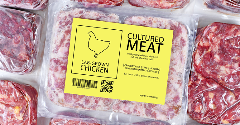News
White Bread and Breakfast Biscuits Fuel Fibre Focus
10 Nov 2014Awareness of the health benefits of fibre in terms of digestion, cholesterol reduction and diabetes prevention is rising, but it is an increasingly complicated area with the traditional associations of fibre with wholegrains, oats and fruit and vegetables now running alongside growing use and awareness of newer sources such as prebiotics, resistant starch, beta glucans […]

Awareness of the health benefits of fibre in terms of digestion, cholesterol reduction and diabetes prevention is rising, but it is an increasingly complicated area with the traditional associations of fibre with wholegrains, oats and fruit and vegetables now running alongside growing use and awareness of newer sources such as prebiotics, resistant starch, beta glucans and so on. The rising number of ingredients now classified as dietary fibre offers options for use in many different types of products with a range of benefits.
Bakery products are, perhaps not surprisingly, the leading user of fibre-related claims in the food and drinks industry, primarily ‘high in fibre’ or ‘source of fibre,’ but also including ‘added fibre’.
According to Innova Market Insights data, bakery products accounted for over one-fifth of global food and drinks launches using this type of claim in the 12 months to the end of September 2014, equivalent to just under 6% of bakery launches as a whole. In addition, a similar number of products used wholegrain claims, although there is some overlap evident, with the two types of claim combined featuring in 9% of global bakery introductions, rising to 14% in the US.
Within the bakery market, biscuits accounted for over half of introductions using fibre-related claims (excluding wholegrains), ahead of bread with just under one-third. In terms of significance to overall launch activity, however, bread leads with products featuring fibre claims accounting for 10% of the total, compared with less than 6.5% in biscuits.
Key areas of interest in the bread market have been in high-fibre white breads and in developing higher-fibre and wholegrain options in the sandwich alternatives market, which has seen the growing popularity of thinner bread rolls and flatbreads with names such as Sandwich Thins and Sandwich Rounds, offering a lighter option for fillings.
In the biscuits market, probably the key area of activity in high-fibre products in recent years has been in breakfast biscuits, virtually all of which are promoted as high in fibre and/or wholegrains and many of which have variants such as fruit and fibre in their ranges. While biscuit consumption at breakfast time is relatively commonplace in some parts of the world, initiatives led by Mondelez and its Belvita brand have targeted expanding the concept into new countries. This started in the UK with the 2010 launch of Belvita, which created a new breakfast biscuits sub-category that now features a raft of brands from cereal companies, biscuit companies and bakery companies, as well as retailer own brands, and heralded a welter of activity in other countries, including Germany, the US and Australia, as well as a revamp of existing markets, such as France and Spain.
The other area of significant activity in bread and biscuits in particular has been in the growing use of ancient grains, with a focus on their nutritional content, including their high-fibre properties.
The bakery industry is focusing on fibre content as one of a number of product benefits to drive sales in a relatively mature and increasingly concentrated market. This has been led by the bread category, with the US at the forefront of development, although it is also apparent across most countries where bread is a staple part of the diet. The rest of the bakery market has also started to focus more on fibre content and wholegrains, although the more impulse and treat nature of many of the products, particularly cakes and sweet biscuits, can make it of less significance in those markets overall.
Related news

‘Health’ labels on products reduce consumers’ willingness to pay
10 Mar 2025
A study into front-of-packaging “health” labelling finds that these labels alone can lower US consumers’ willingness to pay.
Read more
Smaller snack sizes represent big growth opportunity for PepsiCo
5 Mar 2025
Brands are responding to consumer demand for healthier products by developing classic snacks in smaller portion sizes, meaning fewer calories, lower sodium, and lower fat.
Read more
Is the price of a sustainable and healthy diet… unsustainable?
4 Mar 2025
Healthier foods are more than twice as expensive per calorie as less healthy foods, with healthier food increasing in price at twice the rate in the past two years.
Read more
F&B industry hit with fresh greenwashing claims
26 Feb 2025
The food and beverage (F&B) industry is under fresh scrutiny amid claims of greenwashing, with Arla the latest company in the firing line.
Read more
Mealworm protein faces commercial roadblocks as producers struggle
25 Feb 2025
The financial struggles of Ÿnsect, one of Europe’s largest insect protein producers, have raised concerns about the viability of large-scale mealworm farming.
Read more
Water lentils approved as a vegetable in the EU
24 Feb 2025
Water lentils have received approval from the European Food Safety Authority (EFSA) for production and consumption as fresh vegetable in the EU.
Read more
Cultivated seafood company roe-volutionising the caviar market
21 Feb 2025
A Singapore-based startup is targeting premium markets and younger consumers with its latest innovation – cultivated caviar.
Read more
Protein diversification: A massive missed market?
20 Feb 2025
Germany and the UK could be missing out on the massive market for alternative meats and proteins, with one new coalition calling for an end to the “steak-tofu struggle”.
Read more
Singapore explores farmland-free food production
17 Feb 2025
Researchers discover new technology replicating on-farm food production conditions from within the indoor lab environment.
Read more
Indians enjoy first bites of cultivated chicken
13 Feb 2025
The first public tasting of cultivated meat in India has taken place as the country prepares for the first commercial cultivated meat products – potentially as early as the end of this year.
Read more
